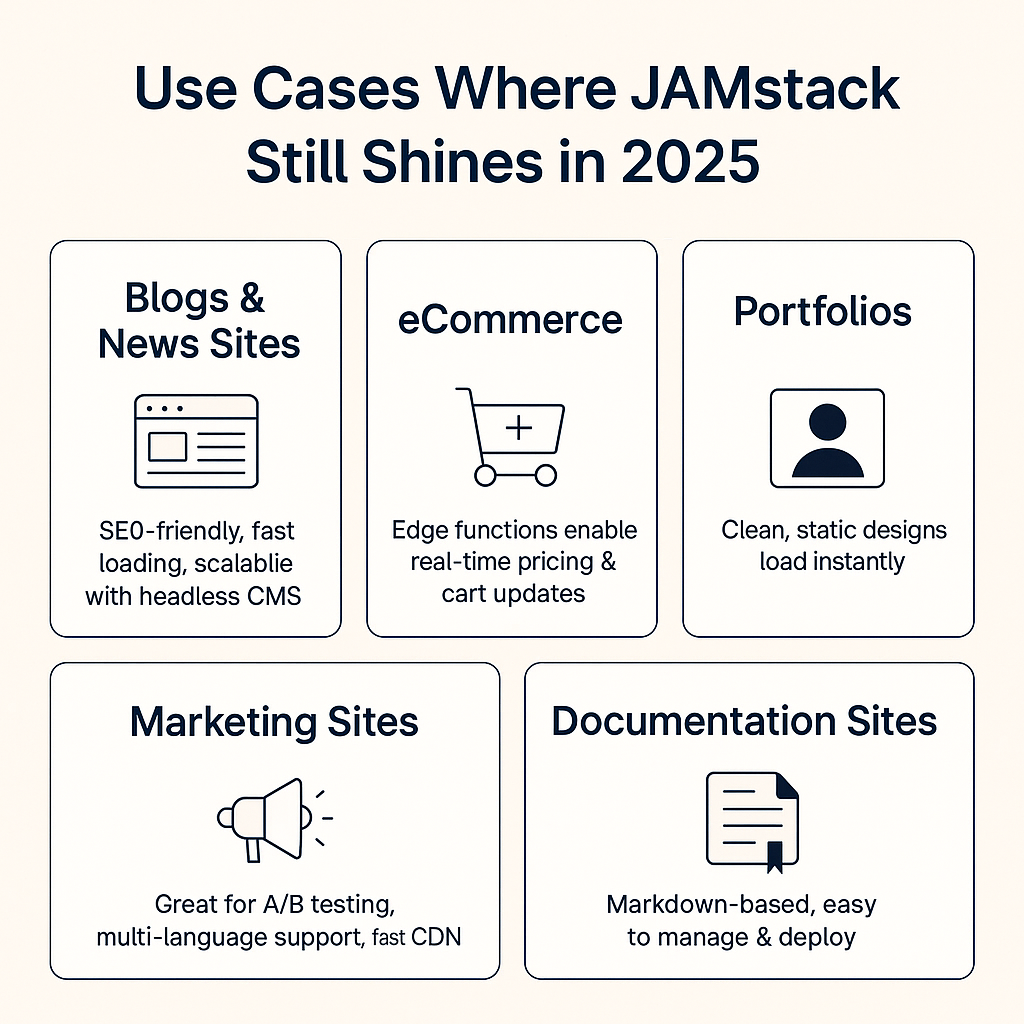
jamstack
JAMstack evolution
Serverless architecture
Headless CMS
The web development world is evolving fast. AI, serverless architecture, and edge computing are pushing the limits of what’s possible. In this landscape, one question arises again: Is JAMstack still relevant in 2025? Since its rise to popularity in the late 2010s, JAMstack has stood out for offering blazing-fast websites, unmatched security, and a clean separation of concerns. But is it keeping up with the newer trends? Or has it evolved into something beyond its original form?
🧱 What is JAMstack?
JAMstack stands for:
- JavaScript – the language running on the client-side
- APIs – services used to perform server-side operations
- Markup – pre-rendered HTML files served via CDN
This architecture decouples the frontend from the backend. Unlike traditional stacks like LAMP (Linux, Apache, MySQL, PHP), JAMstack focuses on pre-building pages during deployment and fetching data from APIs, which are often serverless.
🚀 Why JAMstack Was Revolutionary
When JAMstack emerged, it tackled many problems developers faced with monolithic or server-heavy architectures:
- Performance: Pages are pre-built and served from CDNs, leading to ultra-fast load times.
- Security: With no direct connection to a database or server, the attack surface is much smaller.
- Scalability: Content can be distributed globally with minimal configuration.
- Developer Experience: Developers could focus on frontend logic using modern JavaScript frameworks.
🔄 How JAMstack Has Evolved in 2025
In 2025, JAMstack has evolved far beyond its early form. It’s no longer just static sites built with Markdown. Here's how it's changed:
1. Modern Frameworks Have Redefined JAMstack
- Next.js, Nuxt.js, and Astro support hybrid rendering — combining SSG, SSR, and ISR.
- You can now create dynamic experiences without breaking JAMstack principles.
Example: A blog can serve static content, while the comment section is rendered server-side using serverless functions.
2. Edge Computing & Serverless Dominate
Platforms like Vercel, Netlify, and Cloudflare now provide edge functions, bringing backend logic closer to users.
- Faster response times
- Better personalization
- Real-time features like live chat or product recommendations
3. Headless CMS Integration is Standard
In 2025, the JAMstack ecosystem thrives with AI-powered Headless CMS like:
- Sanity (real-time collaboration, AI-assisted content)
- Contentful
- Strapi
- Payload CMS
These CMS tools offer powerful APIs, perfect for the JAMstack architecture.
4. AI is Embedded in the Workflow
- JAMstack sites are integrating AI chatbots, content personalization, and natural language search.
- These features run on APIs or edge functions — fully aligned with JAMstack's decoupled structure.
5. JAMstack Is Going Enterprise
Previously, JAMstack was seen as a “developer favorite” or for startups. Now, enterprise companies are building JAMstack sites because:
- Performance boosts SEO and conversions
- Headless architecture scales globally
- Reduced server maintenance lowers cost
✅ Use Cases Where JAMstack Still Shines in 2025

Use Cases Where JAMstack Still Shines in 2025
⚠️ Limitations of JAMstack in 2025
JAMstack isn't perfect, and there are some challenges:
1. Complexity for Beginners
- Working with multiple APIs, CMS platforms, and deployment tools can be overwhelming.
2. Overhead for Dynamic Content
- Heavy dynamic features (like dashboards) require custom serverless logic, which can be hard to scale.
3. Cost Control
- Combining too many third-party services can increase hosting and API usage costs.
4. Build Time for Large Sites
- Large-scale static sites can have long build times. Solutions like ISR and on-demand builds are helping solve this.
🔮 What’s the Future of JAMstack?
JAMstack is not fading. It’s transforming.
In 2025, the JAMstack ecosystem is more flexible, developer-friendly, and business-oriented than ever before.
Expect to see:
- More AI integrations via APIs
- Improved DevOps workflows for CI/CD
- Decentralized hosting and edge-first strategies
- More low-code/no-code tools for JAMstack
🧠 Final Thoughts
In 2025, JAMstack remains highly relevant, but not in the same way it was in 2020. It’s no longer just about static sites — it's about modular architecture, edge computing, smart APIs, and lightning-fast performance.
If you're a developer, business owner, or startup founder, embracing JAMstack could future-proof your web projects for years to come.
